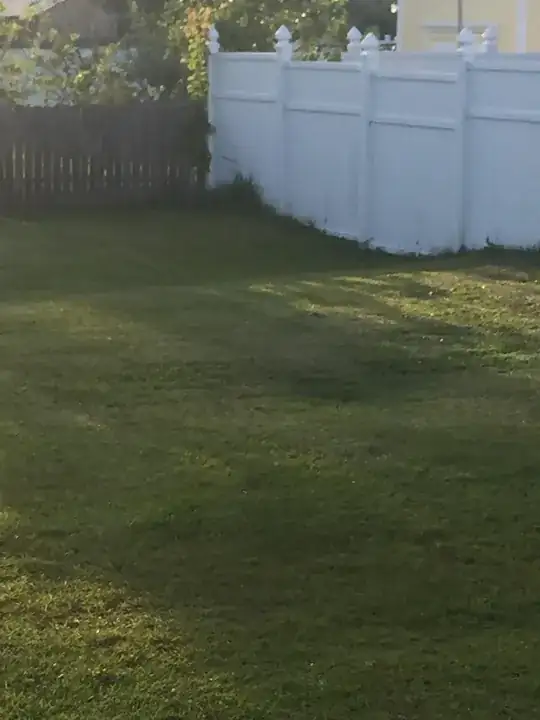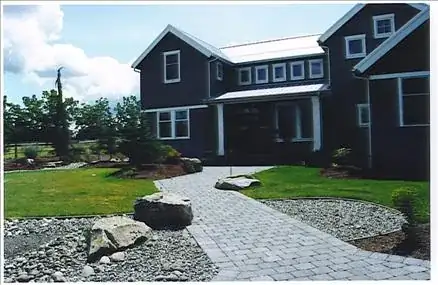
On the other side of the fence in my neighbors yard is a culvert but I am not positive that I can utilize his yard to help my case. What are my options here?

On the other side of the fence in my neighbors yard is a culvert but I am not positive that I can utilize his yard to help my case. What are my options here?
I am assuming the picture is of your yard? Where does the water go once in that swale? If you can find the low spot in your yard where you don't care about having lawn you can dig a large hole to make a 'dry well'. Very easy and inexpensive to do. I'd need to know how large your back yard is in sq. ft. A dry well is just this hole oh, 6' X 4' X 3' ? Lined with landscape fabric, back filled  with 1 1/2 inch drain rock, not crushed gravel but rounded river rock. Then covered with landscape fabric (this is just to keep your drain rock from disappearing and getting clogged up with soil) and I usually cover it with pea gravel, river cobble for a 'dry pond' or 'dry stream' look. It can be covered with sod but that sod will always look different than the rest of your lawn.
with 1 1/2 inch drain rock, not crushed gravel but rounded river rock. Then covered with landscape fabric (this is just to keep your drain rock from disappearing and getting clogged up with soil) and I usually cover it with pea gravel, river cobble for a 'dry pond' or 'dry stream' look. It can be covered with sod but that sod will always look different than the rest of your lawn.
Depending on the slopes you could use french drains in a herringbone pattern to collect and direct water to your dry well. If this swale is yours that would be an obvious place for a dry well and a dry stream treatment. Huge expanses of lawn are highly over rated.
As for the dips, simply get a couple of yards screened topsoil, maybe even less and top dress your lawn filling in the dips, grade like crazy and rent a water filled roller to compact the entire lawn. Grade again, adding more soil where you see any dips. Keep the soil very thin on the rest of your lawn. Roll again. Problem with you lawn is someone missed the rolling step. Use a spreader and reseed your lawn with a great seed mix. Lightly use a soft rake, leaf rake turned over to scratch your seed a bit into the soil. Roll again. You'll still see lots of seed, no worries. Don't overdo the seeding. Water shallowly to keep the germinating seed bed moist not soaked until you've got enough top growth to do your virgin mow. Mow no shorter than 3". This is critical. Start watering more deeply and do not water again until you are able to see your footprints where the grass doesn't pop back up. Never water until you are able to see your footprints. Hold off on fertilizer while starting your seed. The lawn will grow up through the soil and the new grass will help fill in holes. Aerate by pulling cores once per year. Check out all the other question answers on lawn management of cool season grasses.
One more thing I see in your picture. That very nice white fence/screen won't last for long with all that grass and soil able to rot the bottom. Dig that down so you've got 2 inches at least between soil and wood. I'd take that grass back at least a foot and install crushed gravel with a 2X4 PT edger between the gravel and lawn. Allow to go gray. Don't paint it white, please. Looks like the intersection of that white screen and your swale is the low spot? Good place for the dry well?
Edges between your lawn and plant beds should be a shallow trench to collect excess water and make a crisp clean edge with set radius curves. Doesn't matter the size of the radius but the curve stays the same until the curve has to go in the opposite direction. Use upside down paint and a stake with string. Feel free to expand your beds and minimize lawn. Big beds and a defined lawn area.
This will give you some ideas but to answer we need all these questions answered and a few more pictures. This picture shows lawn that has been cut too short and wish I had a picture when they got their landscape maintenance company to keep the length at 3". Also note the plant beds. Always raised above the lawn height with trenches between grass and beds.
Never, even if your neighbor agrees drain your water onto another property. I can give you a few horror stories of neighbors that are no longer friends and lawyers were able to afford maybe some new furniture?
How effective, if at all, may depend upon what is underneath your grass but you might consider burying water crates under the low spots. Something like this:
They can be stacked to increase the reservoir size.
The object being to provide somewhere for the water to go, other than settle on top of your lawn, while you wait for it to dissipate (diffuse through the sides of the crate as surrounding soil dries out). If you are on deep, heavy clay diffusion might be slow but at least you would have the spoil from the hole to raise the hollow up to the surrounding level.
A more expensive solution would be a sump (like a concrete-sided swimming pool with a permeable lid, underground) with pipework and a level-activated electric pump to raise the water collected, when copious, into mains drainage.